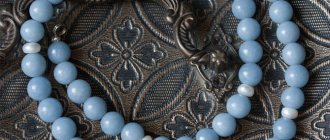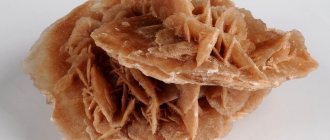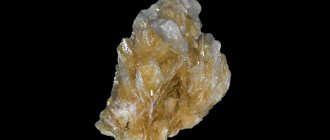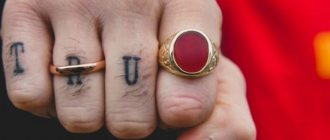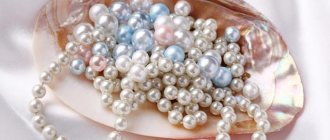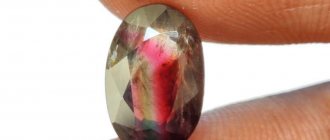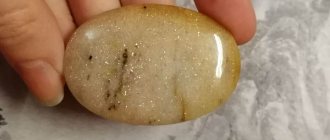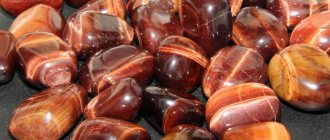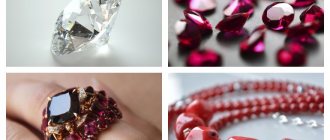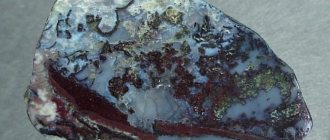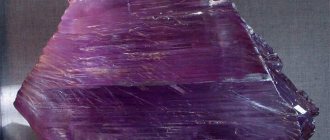Description
Shattuckite is a blue transparent or translucent gem. Copper makes it bright blue, but the color can also be greenish.
In nature, these are needle crystals or pellet agglomerates (spherulites).
There is a misconception that this is a type of chrysocolla. Blue jadeite and shattuckite are also confused.
They are really similar, but they are three independent minerals.
Physico-chemical characteristics
For a chemist, shattuckite is a copper silicate of complex composition and long formula.
Formed in places of oxidation of copper ores.
| Mineral color | light blue turning into dark blue; stroke color light blue |
| Transparency | translucent, transparent or translucent |
| Shine | silky |
| Cleavage | perfect in {010} and {100} |
| Hardness (Mohs scale) | 3.5, on the polished surface of spherulites up to 6-7 |
| Density (measured) | 4.11 g/cm3 |
| Density (calculated) | 4.128 g/cm3 |
| Radioactivity (GRapi) | 0 |
The mineral has several unique properties: contains water (up to 6%); polishes well, after which the surface becomes twice as hard.
Endowed with the ability to “bring copper”: when heated with a soldering tube, it releases pure copper.
Shattuckite.
Shattuckite is a rare copper mineral that has a pleasant bright blue color.
Dense fibrous varieties are used as jewelry or ornamental stone. Named after the location of its discovery - the Shattuck mine, env. Cochise, Arizona, USA. It was first described by the American mineralogist W. T. Schaller (Waldemar Theodore Schaller) in 1915. Composition: copper silicate - Cu5(Si2O6)2(OH)2. The crystal system is rhombic. Water content is about 6%. Characteristic impurities: iron, calcium, magnesium, manganese. It occurs in the form of small elongated prismatic or needle-shaped crystals; forms fibrous and radial aggregates, spherulites, crusts, dense cryptocrystalline and fine-grained masses. Color: from light blue to dark blue; sometimes with a greenish tint. The color is due to divalent copper ions. Translucent to transparent. Gloss: glassy, silky.
Cleavage is perfect in two directions. Fragile. The fracture is uneven. Hardness: 3.5 - 4. Average specific gravity: 4.15 g/cm3. It has a distinct pleochroism ranging from pale blue to dark blue. Refractive index: 1.752 - 1.815. Trait: light blue. Dissolves in hydrochloric acid. Colors the blowpipe flame green.
Shattuckite is quite rare. It is formed as a secondary mineral in zones of oxidation of copper ores. Pseudomorphoses based on chrysocolla and malachite are characteristic.
Known in a number of deposits in southern Arizona (USA), where it was discovered. In 1958, another rare copper mineral with a pleasant greenish-blue color was first described in the same region - achoite, with which it is often found together.
Shattuckite (blue) and ahoite; New Cornelia deposit, Arizona, USA. © Lou Perloff
Other associated minerals include: quartz, papagoite, plancheite, olivenite, conichalcite, albite, muscovite.
Shattuckite was later discovered in other regions of the United States - California, New Mexico, Nevada. Nowadays, its finds are known in Austria (Carinthia), Greece (Southern Sporades), northern Germany (Schleswig-Holstein), Mexico (Sonora), Argentina (Cordoba), D.R. Congo (Katanga Plateau), Namibia ( Erongo), South Africa (Limpopo Province).
Shattuckite has a pleasant blue color and takes polish well.
Jewelry material often contains inclusions of other minerals. Products made from such stone look very attractive. Shattuckite is similar to plancheite, achoite, kinoite and some other rare copper silicates. With its beautiful color, it resembles such popular jewelry stones as chrysoprase, turquoise, and chrysocolla.
Where is the gem used?
Shattuckite is capable of producing pure copper, but is so rare and expensive that it is not used in industrial production. It has found application in the beauty industry.
Jewelry
Craftsmen create almost a full range of jewelry. The most popular are pendants, earrings, brooches or sets of them. In jewelry, Shattuckite is often combined with Eilat stone and chrysocolla.
Jewelry from Shattuckite
The usual setting for products is silver or jewelry alloy. The stone is magnificent in white gold or platinum, but such products are created only to order.
Decor
Small plastic materials, frames, and decor for mirrors and tabletop cutlery are made from agglomerates.
Balls, pyramids, and mineral eggs are intended for adherents of esoteric practices.
Collecting
Raw shattuckite from various deposits is often offered to collectors with some other mineral. It can take years to create a personal collection of this gem, but the result will be impressive.
History and deposits of stone
A rare and modest guest in the kingdom of jewelry, this mineral is nevertheless very beautiful. First found in North America (Arizona), near the city of Cochise, in the mines of the Shattuck deposit. This is where it got its name. It was found and described at the beginning of the 20th century (1915) by W. T. Schaller, an American mineralogist. Later it was found in other mines in North America (Nevada, California and New Mexico), in England and in Namibia. At the end of the 20th century it was found in Greece, Congo and Mexico. It is easy to confuse with another rare mineral – plancheite.
Topic: What does chrysocolla stone look like? Its description, properties, appearance
How to wear and care
The gem is fragile, has a hardness on the Mohs scale below average, so you need to care for it carefully:
- Protect jewelry with shattuckite from temperature extremes.
- Do not drop, do not press, do not squeeze.
- Remove dirt with warm water and soap.
- The energetic dirt is washed off with clean water, after which the stone is exposed to the sun to dry.
Jewelry with Shattuckite should not be worn constantly: the stone is too energetically strong. It will be useful for him and the person to “rest” from each other for at least a couple of days.
Formally, this is an ornamental or semi-precious stone, but its rarity increases its jewelry level. A product with a gem in white gold or platinum is appropriate for a status event; a silver one is suitable for the office.
How to spot a fake
Shattuckite is rarely counterfeited, often offering plastic. The origin of such a sample easily reveals the lightness and clarity of the pattern.
Much more often, you can buy turquoise or chrysocolla under the guise of a stone. They look similar, but you can tell one gem from another:
- Turquoise is much harder.
- The luster of shattuckite is silky. Chrysocolla is waxy or greasy, turquoise is matte.
- The color of Shattuckite is more saturated than those of these gems.
- Turquoise or chrysocolla do not occur in crystal form.
Replacing one natural stone with another is not pure deception. Shattuckite is just less common and more expensive.
Shattuckite 44.2
Collectible mineral shattuckite.
PROPERTIES OF SHATTUCKITE STONE
Shattuckite
Shattuckite is a rare copper mineral that has a pleasant bright blue color. Dense fibrous varieties are used as jewelry or ornamental stone. Named after the location of its discovery - the Shattuck mine, env. Cochise, Arizona, USA. It was first described by the American mineralogist W. T. Schaller (Waldemar TheodoreSchaller) in 1915.
Composition: copper silicate - Cu5(Si2O6)2(OH)2. The crystal system is rhombic. Water content is about 6%. Characteristic impurities: iron, calcium, magnesium, manganese. It occurs in the form of small elongated prismatic or needle-shaped crystals; forms fibrous and radial aggregates, spherulites, crusts, dense cryptocrystalline and fine-grained masses. Color: from light blue to dark blue; sometimes with a greenish tint. The color is due to divalent copper ions. Translucent to transparent. Gloss: glassy, silky.
Cleavage is perfect in two directions. Fragile. The fracture is uneven. Hardness: 3.5 - 4. Average specific gravity: 4.15 g/cm3. It has a distinct pleochroism ranging from pale blue to dark blue. Refractive index: 1.752 - 1.815. Trait: light blue. Dissolves in hydrochloric acid. Colors the blowpipe flame green.
Shattuckite is quite rare. It is formed as a secondary mineral in zones of oxidation of copper ores. Pseudomorphoses based on chrysocolla and malachite are characteristic.
Known in a number of deposits in southern Arizona (USA), where it was discovered. In 1958, another rare copper mineral with a pleasant greenish-blue color was first described in the same region - achoite, with which it is often found together.
Shattuckite (blue) and ahoite; New Cornelia deposit, Arizona, USA. © LouPerloff
Other associated minerals include: quartz, papagoite, plancheite, olivenite, conichalcite, albite, muscovite.
Shattuckite was later discovered in other regions of the United States - California, New Mexico, Nevada. Nowadays, its finds are known in Austria (Carinthia), Greece (Southern Sporades), northern Germany (Schleswig-Holstein), Mexico (Sonora), Argentina (Cordoba), D.R. Congo (Katanga Plateau), Namibia ( Erongo), South Africa (Limpopo Province).
Shattuckite has a pleasant blue color and takes polish well. Jewelry material often contains inclusions of other minerals. Products made from such stone look very attractive.
Therapeutic effect
Lithotherapists have established a list of the healing properties of the stone:
- It is recommended to wear it for tonsillitis, chronic rhinitis, inflamed tonsils, and eye diseases.
- Helps to recover after surgery or serious illness.
- Supports the body weakened by mineral and vitamin “starvation” in the spring.
- Increases blood clotting.
- A pebble near the head of the bed or under the pillow is indicated for anxious, interrupted sleep, and insomnia.
The main significance of the stone is to delicately regulate the functioning of the body. Shattuckite is especially beneficial for people with weakened immune systems.
Healers recommend wearing pendants and pendants in a white frame (nickel silver, silver).
Healing abilities
Endowed with a magic crystal and incredibly strong healing qualities. The stone helps its owners overcome and prevent further acute respiratory viral infections, improve blood clotting and activate the proper functioning of internal organs. Shattuckite jewelry, especially set in silver or white gold, is recommended for people with weakened immune systems, as such jewelry has the ability to correct the functioning of all body systems. The crystal gently restores tone after illnesses or a lack of beneficial microelements and vitamins important for health.
If there is an inflammatory process in the tonsils, then the mineral will help stop it.
Traditional healers recommend wearing shuttaket to people with inflamed tonsils, eye diseases and nasal congestion. To do this, you should place a stone near the bed and always carry it with you. In addition, if you place a magic crystal at the head of the bed, you will be able to restore sound sleep, get rid of insomnia and nightmares.
Magic properties
The magical properties of Shattuckite are aimed mainly at the spiritual sphere:
- The stone makes a person immune to curses, magical attacks, the evil eye, and other negativity.
- Cleanses the aura.
- Creates a “bridge” with the energy of the Universe.
With such a talisman it is easier to enter a trance, remember dreams or master lucid dreams.
The owner of the amulet will receive help in more “prosaic” matters:
- He will become a speaker capable of convincing any interlocutor.
- Realizes the value of life, finds himself and his business.
- He will be an optimist, trusting himself and the Higher Power as a guide through life.
- He will become wiser and will be able to “read” other people’s thoughts.
Shattuckite magic does not work for nefarious intentions. This is a positive stone.
Its value is invaluable for a suspicious person who does not believe in himself. The pebble will not allow him to be hypnotized or subjugated by other mental means.
